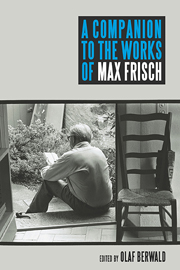Book contents
- Frontmatter
- Contents
- Acknowledgments
- Note on the Abbreviations
- Introduction: Max Frisch in the Twenty-First Century
- 1 Max Frisch's Early Plays
- 2 Spielraum in Max Frisch's Graf Öderland and Don Juan: Transparency as Mode of Performance
- 3 Max Frisch's Biedermann und die Brandstifter and Die große Wut des Philipp Hotz
- 4 Max Frisch's Andorra: Balancing Act between Pattern and Particular
- 5 Eternal Recurrence in Life and Death in Max Frisch's Late Plays
- 6 Max Frisch's Early Fiction
- 7 From Life to Literature: Max Frisch's Tagebücher
- 8 “Writing in order to be a stranger to oneself”: Max Frisch's Stiller
- 9 Cybernetic Flow, Analogy, and Probability in Max Frisch's Homo Faber
- 10 The Ends of Blindness in Max Frisch's Mein Name sei Gantenbein
- 11 Max Frisch's Montauk. Eine Erzählung
- 12 Man, Culture, and Nature in Max Frisch's Der Mensch erscheint im Holozän
- 13 “My life as a man. Everyman”: Max Frisch's Blaubart. Erzählung
- 14 Max Frisch's Essays and Speeches
- Frisch's Major Works
- Select Bibliography
- Notes on the Contributors
- Index
9 - Cybernetic Flow, Analogy, and Probability in Max Frisch's Homo Faber
Published online by Cambridge University Press: 05 December 2013
- Frontmatter
- Contents
- Acknowledgments
- Note on the Abbreviations
- Introduction: Max Frisch in the Twenty-First Century
- 1 Max Frisch's Early Plays
- 2 Spielraum in Max Frisch's Graf Öderland and Don Juan: Transparency as Mode of Performance
- 3 Max Frisch's Biedermann und die Brandstifter and Die große Wut des Philipp Hotz
- 4 Max Frisch's Andorra: Balancing Act between Pattern and Particular
- 5 Eternal Recurrence in Life and Death in Max Frisch's Late Plays
- 6 Max Frisch's Early Fiction
- 7 From Life to Literature: Max Frisch's Tagebücher
- 8 “Writing in order to be a stranger to oneself”: Max Frisch's Stiller
- 9 Cybernetic Flow, Analogy, and Probability in Max Frisch's Homo Faber
- 10 The Ends of Blindness in Max Frisch's Mein Name sei Gantenbein
- 11 Max Frisch's Montauk. Eine Erzählung
- 12 Man, Culture, and Nature in Max Frisch's Der Mensch erscheint im Holozän
- 13 “My life as a man. Everyman”: Max Frisch's Blaubart. Erzählung
- 14 Max Frisch's Essays and Speeches
- Frisch's Major Works
- Select Bibliography
- Notes on the Contributors
- Index
Summary
Wir [sind] denn doch keine kybernetischen Mäuse, gesteuert von “information” und “feed back” und basta.
[After all, we are not cybernetic mice, guided by “information” and “feedback,” once and for all.]
—Max Frisch, Biografie: Ein SpielThe American author Kurt Vonnegut proclaimed, “novels that leave out technology misrepresent life as badly as Victorians misrepresented life by leaving out sex.” If Vonnegut was correct, then Max Frisch's 1957 novel Homo Faber is a remarkably accurate representation of life. Although there is a tendency in some of the secondary literature, as noted by Ferdinand van Ingen in his article on technology and mythology in Homo Faber, to view the protagonist Walter Faber's occupation and his obsession with all things technological as more or less coincidental, and although Frisch himself gave conflicting answers regarding Faber as a “Techniker,” I suggest that technology is indeed a key to understanding this novel. Faber's former lover Hanna Landsberg puts it best when she describes technology as a trick that allows humans to order the world in such a way “daßwir sie nicht erleben müssen” (so that we don't have to experience it). This is Faber's goal. Throughout the text he denigrates “Erlebnisse” and the idea of “erleben.” His connection to the natural world is filtered or mediated by technology, and Faber claims to prefer it that way.
- Type
- Chapter
- Information
- A Companion to the Works of Max Frisch , pp. 140 - 155Publisher: Boydell & BrewerPrint publication year: 2013

